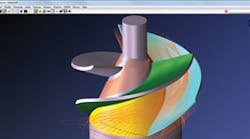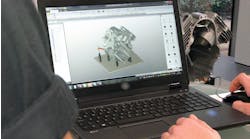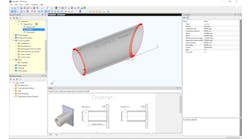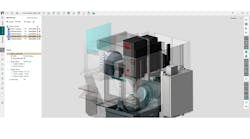Gibbs and Associates, developer of GibbsCAM software for programming CNC machine tools, has released GibbsCAM 2011, which it said includes “dozens of enhancements to make NC programming easier and faster.” According to the group’s founder Bill Gibbs, the 2011 release’s new features improve programming and machining efficiency while retaining GibbsCAM’s ease of use.
Among the multiple additions and enhancements within the 2011 release, are:
Enhanced feature and color recognition and preservation. To optimize efficiency and throughput, new tagging capabilities, combined with automatic feature recognition (AFR), allow users to control how GibbsCAM imports CAD models and manages part features and attributes. Color Modes were added to extend tagging and selection criteria of geometric elements – geometry, faces, surfaces and solids. When a part contains user-defined features, or elements tagged with a color attribute, users can switch among Color Modes to distinguish, select or isolate features or elements for manipulation, copying or machining.
As a result of these enhancements, GibbsCAM can read attributes from CAD models, then recognize and preserve them as attributes in the GibbsCAM part file. Colors are preserved as CAD colors in the part file, and hole features in the model are recognizable and usable as hole features within GibbsCAM hole operations.
Holemaking capabilities for selecting, organizing, recognizing, and drilling holes have been broadly enhanced in GibbsCAM 2011. Hole Manager, a productivity tool within GibbsCAM, now includes a new Auto Wizard that allows users to store default settings for reuse, quickly and easily, at any time. Using AFR, holes (and entities that resemble holes) are selectable by part face, set of faces, a hole’s interior faces, or by coordinate system to which a hole feature is aligned. This streamlining lets users recognize and program hundreds of holes automatically with as few as three mouse clicks, simplifying and speeding up holemaking operations. GibbsCAM now includes support for the full range of SolidWorks hole features, too.
Custom drill cycle options were added and, to reduce traverse and cycle time in drill cycles, a new check box enables reverse-order drilling.
5-axis enhancements include various new drill cycle options, toolpath conversion, toolpath smoothing and additional machining styles. The new hole making features make programming drill cycles at off-axis orientations very easy and extremely fast. Programmers can choose drill, variable peck, tap and custom drill cycles.
A new Operation Modifier makes it possible to convert 2.5- and 3-axis toolpaths for 5-axis machining, which allows use of shorter tools to achieve smoother toolpaths through tool-axis rotation when the work piece or tooling interferes with the tool holder.
Toolpath smoothing methods have been implemented for all types of geometry, both STL (triangle mesh) and traditional surface geometry, to improve both tilt and rotary toolpath smoothness.
Swarf cutting can now be specified two ways. Users can drive the tool using a) upper and lower curves, with or without a drive surface, or b) a parallel-to-curve strategy with tool-axis rotation. Also new is a 5-axis trimming strategy that uses wireframe geometry.
Support for B-axis (tilting live tooling) was added to enable programming 5-axis milling with Y-axis offsets on lathes and multi-task machines equipped with a live-tooling B-axis.






